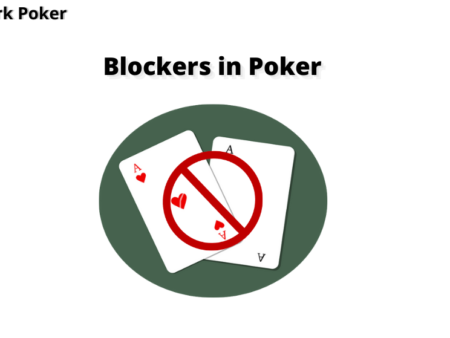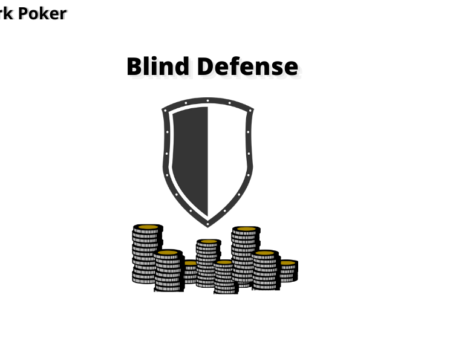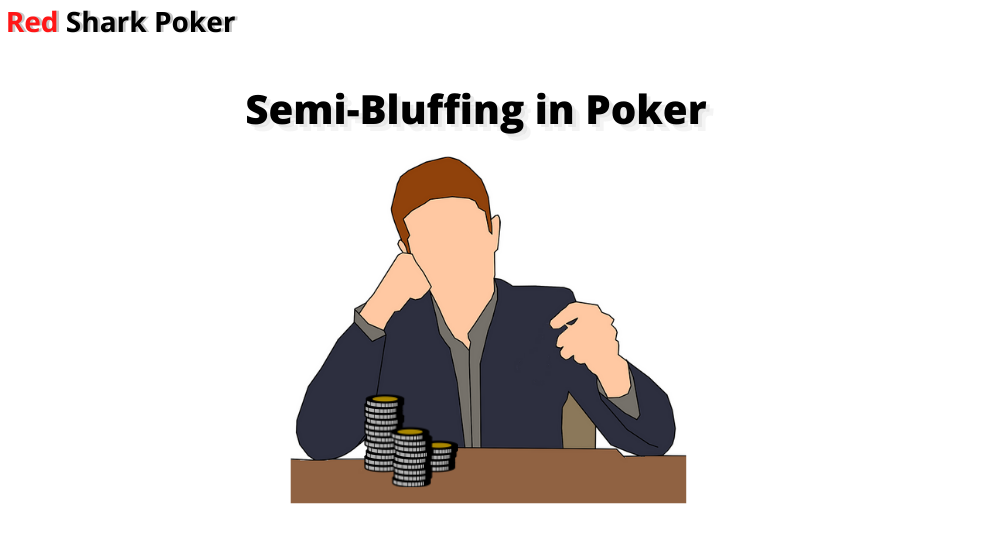
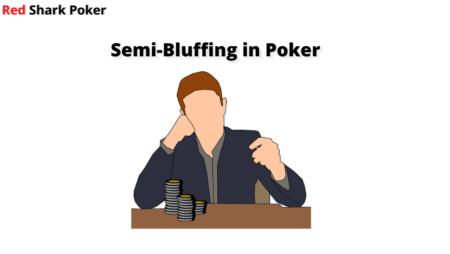
Bluffing is an advanced move in poker that requires a lot of skills and a good read on your opponent. Even if you are a highly skilled player, there is no guarantee that your bluff won’t get caught. However, if you have some outs that can save you on the future street, your bluff can become more profitable. Such a form of bluffing with some outs that can help you to improve your hand on the future streets is called a poker semi-bluff.
What is a Semi-Bluff in Poker?
Semi-bluffing is betting or raising with a hand that is not the best hand on the current street but has the potentiality of becoming the best hand on the future streets. The objective of semi-bluffing is to force the opponent immediately. In case your opponent calls, you still have outs that can help you to improve your hand on the later streets.
An Example of Semi-Bluff
The most common examples of semi-bluffing are betting with a flush draw or a straight draw. If you have not completed your draw, you can still win the pot right away by bluffing. However, if your opponent calls and an out hits on the next street, you will have the best hand.
For example, you are on the button with A♠ 2♠ and call UTG’s raise on the preflop.
Flop: J♠ 7♥ 9♠
UTG checks on the flop. Now you have the chance to semi-bluff. As your opponent checked, he might not have connected with the flop. If you bet here and make your opponent fold, you will win the pot. However, if your opponent calls your bet, you still have 9 outs to make a flush on the later streets.
Calculate Your Equity Before Semi-bluffing
As you noticed, you must have some equity before semi-bluffing in poker. The more outs you have, the more equity you will have while bluffing. Let’s look at the equity chart of the common draws in poker.
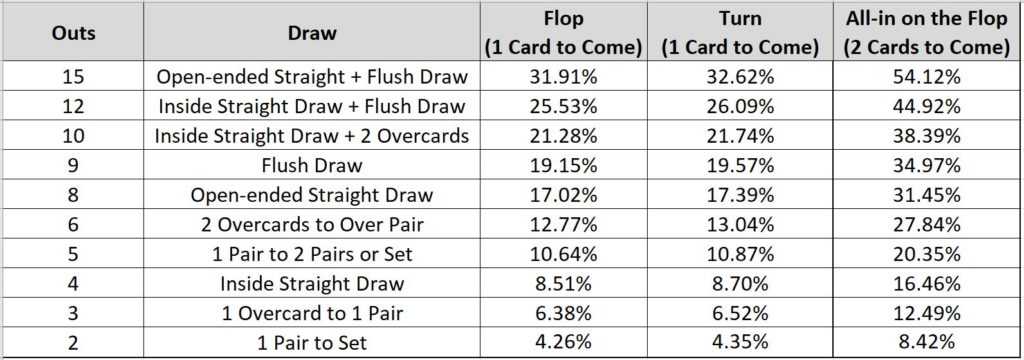
Note: The last column All-in on the Flop (2 Cards to Come) is in a situation when you or your opponent go all-in on the flop. In an all-in situation, you don’t have to call bets on the turn or river. So, you will see 2 cards till the river. Seeing 2 cards instead of 1 improves your odds.
Let’s look at a common turn and compare the equity of different hands when you choose to semi-bluff in poker.
Hand #1: A♠ K♠
Turn: 10♦ 7♥ 3♣ Q♠
You have 6 outs that can make a top pair on the river and 4 outs that can complete an inside straight draw. This gives you a total of 10 outs (21.7% equity).
Hand #2: A♠ 5♠
Turn: 10♦ 7♥ 3♣ Q♠
You have 3 outs that can make a top pair on the river. This gives you 6.5% equity.
Hand #3: 2♠ 2♥
Turn: 10♦ 7♥ 3♣ Q♠
You have only 2 outs that can help you to improve your baby pair to a set on the river. This gives you 4.4% equity.
The first hand is a far better hand than the rest to semi-bluff as you have more outs and equity.
If you don’t know how to calculate outs, click here: How to Calculate Poker Outs?
Good Draws to Semi Bluff
As you can see in the chart above, the draws that have more outs have higher chances of improving on the future streets. So, the good hands to semi bluff are as follows:
Open-ended Straight Flush Draw
It is the best hand to semi-bluff as you have 15 outs to complete your draw. For example,
Your Hand: 5♦ 6♦
Flop: 7♦ 8♣ 2♦
Here, you have four diamonds 5♦ 6♦ 7♦ 2♦ and four connecting cards 5♦ 6♦ 7♦ 8♣. If a diamond-suited card hits the board, you complete your flush. And, if a 4 or a 9 hits the board, you complete your straight.
- You have 31.91% equity on the flop
- You have 32.62% equity on the turn
- You have 54.12% equity if you go all-in on the flop
Many players go all-in on the flop as you have huge equity of 54.12% if you go all-in on the flop.
Inside Straight Flush Draw
It is the second-best hand to semi-bluff as you have 12 outs to complete your draw. For example,
Your Hand: 5♦ 6♦
Flop: 8♦ 9♠ 2♦
Here, you have four diamonds 5♦ 6♦ 8♦ 2♦; if a diamond-suited card hits the board, you will complete your flush draw. Also, if a 7 hits the board, you will complete your inside straight draw.
- You have 25.53% equity on the flop
- You have 26.09% equity on the turn
- You have 44.92% equity if you go all-in on the flop
Inside Straight Draw + 2 Overcards
You have a total of 10 outs – 6 outs to make an overpair and 4 outs to complete an inside straight draw. For example,
Your Hand: A♦ K♣
Flop: J♦ 10♠ 2♣
Here, you have 6 outs that can make an overpair (Aces or Kings) and 4 outs (Queen) that can make an inside straight.
- You have 21.28% equity on the flop
- You have 21.74% equity on the turn
- You have 38.39% equity if you go all-in on the flop
Flush Draw
You have 9 outs to complete your flush draw. For example,
Hand #1: K♦ 6♦
Flop: T♦ K♣ 2♦
Hand #2: A♦ 6♣
Flop: T♦ K♦ 2♦
In both the hands, you need 1 out of the 9 outs (any diamond-suited hand) to complete your flush draw.
- You have 19.15% equity on the flop
- You have 19.57% equity on the turn
- You have 34.97% equity if you go all-in on the flop
It’s better to semi-bluff with big flush draws where you have an Ace or King of the same suit.
Open-ended Straight Draw
You have 8 outs to complete your straight draw. For example,
Your Hand: 5♦ 6♣
Flop: 7♦ 8♣ 2♥
Here, you need a 4 or a 9 to complete a straight. If you hit a 4 on the turn or the river, you complete a straight with 4, 5, 6, 7 and 8. And, if you hit a 9, you complete a straight with 5, 6, 7, 8 and 9. So, the draws are open on both ends.
- You have 17.02% equity on the flop
- You have 17.39% equity on the turn
- You have 31.45% equity if you go all-in on the flop
Weak Draw to Semi Bluff
Don’t bet too much on draws that have fewer outs. You might be in trouble if your outs don’t hit on the board. Check out some of the weak draws that you should semi-bluff cautiously:
Inside Straight Draw
It looks tempting to semi bluff with an inside straight draw, but you should know that there are only 4 outs that can help you on the future streets. For example,
Your Hand: 5♦ 6♣
Flop: 7♦ 9♣ 2♥
Here, you specifically need an 8 to complete a straight; so, you have only 4 outs left.
Weak Flush Draw
Bluff cautiously when you have a weak flush draw. Your opponent might also be chasing his flush draw with the nuts. For example,
Your Hand: 4♦ 5♦
Flop: T♦ K♣ 8♦
If your opponent also has a suited hand with a 6 or above diamond suited card, you will lose to a better flush.
Focus on Making Your Opponent Fold
Remember, semi-bluffing is a form of bluffing. So, the primary objective of semi bluffing remains the same – Making your opponent fold and winning the pot right away. If your opponent calls, it defeats the whole purpose of bluffing. Therefore, the most important factor to consider before semi bluffing is to know how likely is your opponent is going to fold. And for that, you must know your opponent well before bluffing.
Type of Opponent
It is important to assess the type of your opponent before you decide to semi-bluff in poker. Is your opponent playing tight, or is he playing loose?
Against a Tight Opponent: It is easier to force a tight opponent to fold on a wet board with no high cards. If a tight opponent raises on the preflop, you can expect him to have aces, kings, queens and other broadways. If you have A♠ 8♥ and the board reads 5♥ 6♣ 7♠, you can bluff as it is highly improbable for a tight opponent to have these cards. On a wet board like this, you can expect a tight opponent to fold. In case your opponent calls, you still have an open-ended straight draw.
Against a Loose Opponent: It is comparatively difficult to force a loose opponent to fold, especially if he is a loose-passive player (fish). Such players have a tendency to call any bet or raise, and they are likely to catch your bluff if the board improves for them on later streets. Loose-aggressive players have a tendency to raise more often. If you re-raise, you will probably be called by them. So, opt for semi-bluffing only when you have lots of outs.
Number of Opponents
The success of your semi-bluff is directly related to the number of opponents who enter the pot. If multiple opponents call your preflop bet, it is quite difficult to force all the opponents to fold on a bet or raise post-flop. The possibility of pulling a successful bluff drops drastically, as any of the opponents might call. So, it is best to semi-bluff in poker against a single opponent.
Stack Size Comparison
Always compare your stack size with your opponent’s stack. If you have a short stack, it is difficult to make a big-stacked opponent fold, even if you go all-in. For example, if you have a stack of 7 big blinds and your opponent has a stack of 60 big blinds, you can’t expect your opponent to fold. If you go all-in, you are most likely to be called. Similarly, if you have a big stack size, say 60 big blinds, and your opponent has a stack of 5 big blinds, your opponent will most likely call, even if you go all-in.
Also Read: Complete Guide on How to Bluff in Poker
Check-raising as Semi-Bluffs
A tricky way of semi-bluffing is by check-raising with a drawing hand. It is quite difficult to bluff from out of position; however, check-raising from an early position can be a secret weapon to semi-bluff and win pots. Let’s look at two examples where you are playing out of position and semi-bluffing with check-raises.
Example 1
Your Hand: A♦ 9♦
Flop: Q♠ 5♦ 2♦
You have a flush draw and have to act first. You check to see if your opponent bets.
1. If your opponent checks, you get to see a free card.
2. If your opponent bets, you can check-raise here.
When you check-raise here, you have disguised the strength of your hand. Your raise would represent a pair of queens. If your opponent folds, you win the pot right away. However, if your opponent calls and you complete your draw on the next street, your opponent will not likely believe that you have completed your flush. Your bet will seem like bluffs, and you can start extracting value.
Example 2
Your Hand: 8♦ 10♥
Flop: 7♠ 9♥ 2♣
You have an open-ended straight draw. You can choose to check for a chance to see if your opponent bets. Again, your opponent has two options – Check or bet.
1. If your opponent checks, you get to see a free card.
2. If your opponent bets, you can check-raise here.
If your opponent bets, you should check-raise to disguise the strength of your hand. Your raise would represent a top pair. If your opponent folds, it’s all good. If your opponent calls, you can choose to bluff again, depending on the turn card. And, if you complete your draw, you will have a very disguised straight that can help you to extract value.
Read: How to Check-raise in Poker?
Why Should You Semi-bluff in Poker?
When you have draws on a missed flop or turn, most players tend to check to see a free card. When you choose to see a free card, your hand become very obvious, and your opponent will know that you are chasing your draws. Instead of checking, you should semi-bluff to disguise your draws. When you complete your draw, your bets will seem like bluffs, and you can extract value.
Also, you take the initiative while semi-bluffing. Your aggression shows that you have the strongest hand at the table. This might force your opponent to fold right away. So, instead of checking, you should be the one taking the aggression and taking down the pot.
When Not to Semi Bluff in Poker?
As we have mentioned above, semi-bluffing is a form of bluffing. So, don’t attempt to semi-bluff if you think that your opponent is going to call. To determine how likely your opponent is going to fold, it is advised to consider the fold equity.
Fold equity is a basic mathematical concept that helps you to find out the likelihood of your opponent folding to your bet or raise. It is the added equity you gain when you believe that there is a possibility of your opponent folding his hand.
If you want to know how to calculate fold equity, click here: How to Find Out Fold Equity in Poker?
Also, don’t attempt to semi-bluff if the board helps your opponent’s range. Be careful of dangerous boards that largely favour your opponent’s range. Consider your opponent’s playing style and how his range interacts with the board according to his position. For example, if you are in the big blind and a tight player raises preflop from Under the Gun, be very careful of the following board types:
K♠ K♥ T♣
Q♥ A♣ 7♦
K♦ J♦ 9♠
These boards heavily favour your opponent’s range. Your opponent being a tight player, could easily have aces, kings, queens, jacks in his opening range from the UTG position. Bluffing could be disastrous on such boards. So, be very analytical about your opponent’s range and how well the board favours his range and position.
Conclusion
Remember to count your outs and calculate the equity before semi-bluffing in poker. If you have a good number of outs, it is better to take the initiative and bluff instead of checking or calling. When you semi-bluff, you are also disguising your hand that can help you to bluff later depending on the future streets.
A semi-bluff is far safer than a pure bluff, as you can extract a lot of value when you hit your outs. If you are a beginner, practice semi-bluffing first before making pure bluffs. Have a balanced semi-bluffing and value betting ratio so that you become unpredictable at the tables. Good Luck!


